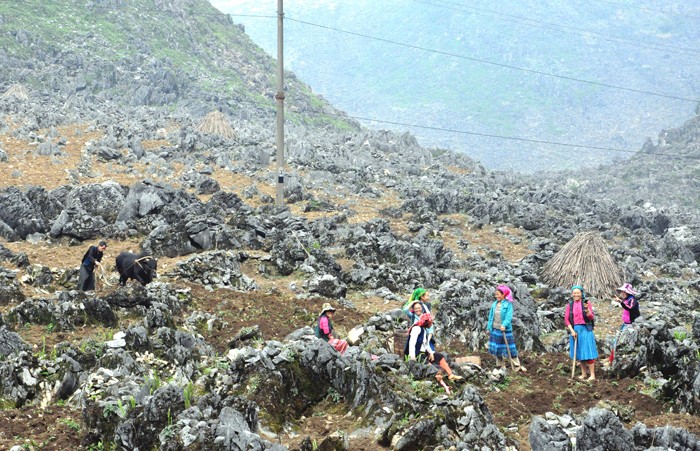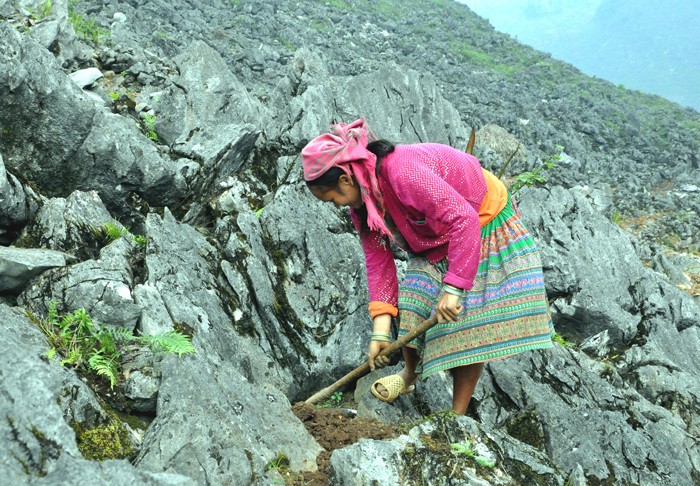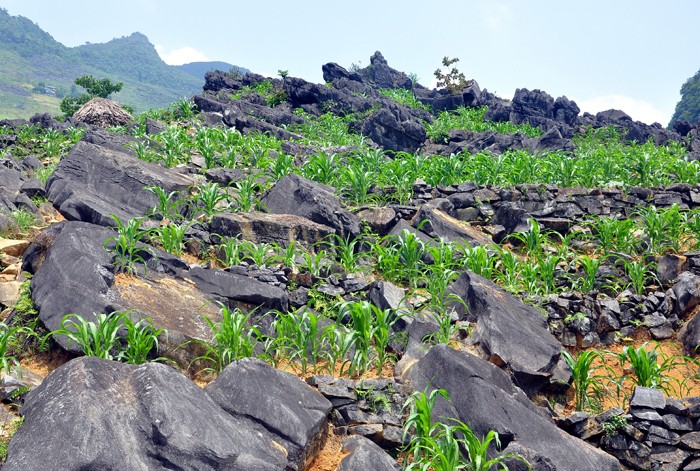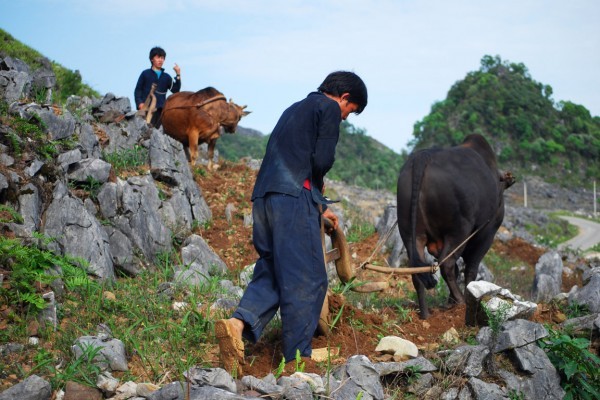Winding roads and terrifyingly steep slopes are what you will see in Dong Van, Yen Minh, and Quan Ba districts of Ha Giang province, home to the Mong ethnic people. Rising out of huge piles of stones, corn fields grow strong and flowering nature amazes visitors with its beauty.
The beautiful natural scenery is enhanced by the local technique of stone niche cultivation - a clever way of thriving in a rugged land used by generations of Mong ethnic minority people.
Dr. Hoang Son, former Deputy Director of the Vietnam Institute of Culture and Art said: "The Mong ethnic people were one of the last northern ethnic groups to emigrate to Vietnam. The most fertile farming areas were already controlled by other ethnic groups, which forced the Mong people high into the mountains, to arid areas where no one else lived. The scarcity hunting and gathering put them in a situation where cultivation was the only way to survive. That necessity drove them to develop a new method of cultivation among the rocky cliffs. We now call it stone niche cultivation."
Ms. Giang Thi Di from Meo Vac town, Meo Vac district, Ha Giang province, said: "Because of the harsh climate and lack of arable land in the highlands, the stone niches are all left for us to cultivate. Planting even one more corn stalk in a stone niche goes a small way toward improving people’s lives."
Mr. Son said that the locals treasure every bud grown in the rocks: "The rugged rock areas contain small stone niches just 30 to 40 centimeters wide on average. The biggest one is about half a square meter. Hot weather in the daytime creates water vapor and cold nights cause dew to collect in the stone niches. So there is only one more task: to create humus and soil in which the plants can grow. I’ll describe the scene: A Mong couple carrying two baskets filled with soil are handling a broken bowl. They scoop and pour the soil into the niches. Big niches get a liberal covering, while small ones get less. Then they plant 1-2 corn grains. When they are finished, they climbed back to the top of the mountain."
 Photo: congthuong.vn Photo: congthuong.vn |
The Mong have become expert at taking advantage of these natural niches. In certain terrains and areas, by applying some ingenuity, they can move stones to make the cultivation space wider.
Corn is a strong self-sustaining plant that can grow in this harsh environment. In this rugged and rocky area, the tools needed are a small knife, a pickaxe, and a sickle. They often use their bare hands to dig.
They carry loads of soil on their backs and fill the holes and niches by hand. The soil will eventually wash away in the rainy season. Then it’s on to the next planting season, and the process repeats. "For a flat space we use the plow. For stone niches and holes we use a pickaxe to create a spaces in which to grow corn. Some grounds are 5 - 6 meters wide, but we have to make sure cows can walk there to plow. The rest can only be cultivated by hand," said Ms Di.
Mr. Sung Sinh Vu of Thanh Ma Tung hamlet, Sa Phin commune, Dong Van district described how the Mong people "force the stones to bloom": "After clearing the weeds, except for niches which can be used right away, we have to add soil, plant a seed, and place a little manure there. We can use dried leaves as additional fertilizer. The Mong people have been climbing these rocks repeatedly throughout their lives, so there is nothing that can hinder us."
 Planting corn seeds (Photo: conthuong.vn) Planting corn seeds (Photo: conthuong.vn) |
After planting corn in the stone niches, rain can wash away the soil and even the corn. But the Mong people have a way to prevent this. Ms. Di explained: "If it is a very steep area, it is a problem. If the holes and niches are formed in the shape of a kettle, whatever is inside tends to stay there, unless a stone falls. In wider areas, we pick up loose stones and place them in a row like a fence. In smaller stone niches, we pick up small stones and place them in rows, like a small wall, to secure the soil and hold the corn stalk in place."
In March, when rice flowers are in bloom and the first rain falls, the Mong begin planting new crops. Planting is done quickly in a window of about 10 to 15 days. Before planting, manure is piled in one corner of the field with which to fertilize each seed after it is planted.
Planting seeds in the stone niches is painstaking work. Carrying soil up from the foot of the mountain is even harder If the rock cavity is too narrow the Mong must use a pickaxe and their bare hands to enlarge the holes.
7 to 10 days after planting the corn seeds, the Mong begin to plant soybeans. Soybeans are grown between the corn beds. There are other inter-crop plants as well. Amaranth or spinach seeds can be mixed with the manure so when people fertilize the corn, the other seeds are also sown. This is a measure to save time and labor, ensuring the seasonality of plants.
Mr. Vu said Mong people can use the farming area numerous times without having to moving to another field: "We stay there. The planting places we create can be used often. There is no need to change or move anywhere. If we succeed in harvesting the spring-summer corn crop there, we continue with other vegetables for the winter crop - soybeans, green beans, green vegetables, grass ,or buckwheat. Of course, we have to fertilize the soil again. To plant other crops, we have to repeat the process over and over again."
 A corn field on rocky mountain (Photo: congthuong.vn) A corn field on rocky mountain (Photo: congthuong.vn) |
Collecting corn is the main task of the Mong people during the harvest season. Inter-crops are continuously harvested throughout the season. In addition to the skill needed to farm rocky areas, they must understand the weather in order to know when to plant. January is the best time to prepare the soil. In February, when the weather is still slightly foggy, families must plant the seeds. Mr. Vu said: "Only one corn crop can be grown each year. We plant it for the right season, it is very difficult, and there must be a gap of at least one week between soil preparation and planting. We have to base the timing on the weather. For very elevated areas subject to drought, we might have to wait until April for rain. In February or March, we must immediately plant. Otherwise the crops is not guaranteed. There are many problems we have to overcome without fail. "Live on rocks and die buried in rocks." Even if we have to sacrifice ourselves, we must overcome the problems for our people and for the sake of our livelihood."
With the ultimate goal of a prosperous, happy life and with the strongest of wills, the Mong people have managed to "force the rocks to bloom". Human labor and creativity have created a masterpiece of cultivation that amazes visiting tourists. In 2014, the stone niche cultivation technique of these highland residents was included in Vietnam's intangible cultural heritage list by the Ministry of Culture, Sports and Tourism.
The Mong ethnic minority’s painstaking approach to farming on the Dong Van Karst Plateau in Ha Giang reveals an incredible ability to adapt to harsh surroundings and persevere against pitiless elements. Mr. Hung Dinh Quy, Former Director of Ha Giang Department of Culture, said: “There is nowhere else on earth where human beings have to farm in such rocky and harsh conditions. Only in the Dong Van, Meo Vac districts of Ha Giang province, where there is not enough farm land, do people carry soil from the foot of the mountain to where they plant their crops.”
Transforming the land has meant building rocky dykes to contain the loam pushed into the fields from mountain tops during heavy rains. The Mong people begin their work on the rocky fields in the winter, around November until January. First, they cut down big trees, remove wild weeds, and smooth the ground. Rock dykes are made from the bottom up. They will dig a small channel running through their farming area. Stones are collected nearby and put into rings around the plot. Most of the time, the Mong people have to break big stones to have enough materials for the dykes. They are very skillful when it comes to building stone dykes. Mr. Quy said: “In using rocks as building materials, the Mong people of the Dong Van, Meo Vac districts are as skilled as engineers at the National University of Construction and Engineering. They accumulate experience from childhood, when they follow their parents into the fields. The Mong people have mastered the construction of rock walls, fences, and dykes to aid their farming.”
 Photo: congthuong.vn Photo: congthuong.vn |
The Mong use hammers to break big stones and remove sharp, uneven edges so the dykes are strongly connected. The height of a dyke depends on the steepness of the ground, but is usually around 60 cm. The Mong are very skilled at selecting rocks. Gray rocks are easier to break and are widely chosen. White rocks are much harder. The work is tedious, long, and exhausting.